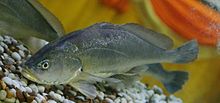Boesemania is a monospecific genus of freshwater fish in the family Sciaenidae. This genus contains the single species Boesemania microlepis.[4][2] Also known as the Boeseman croaker and smallscale croaker, this fish lives in southeast Asian rivers.[1]
| Boesemania | |
|---|---|

| |
| Scientific classification | |
| Domain: | Eukaryota |
| Kingdom: | Animalia |
| Phylum: | Chordata |
| Class: | Actinopterygii |
| Order: | Acanthuriformes |
| Family: | Sciaenidae |
| Genus: | Boesemania Trewavas, 1977 |
| Species: | B. microlepis
|
| Binomial name | |
| Boesemania microlepis | |
| Synonyms[3] | |
| |
Taxonomy edit
Boesemania was first proposed as a monospecific genus in 1977 by the English ichthyologist Ethelwynn Trewavas with Johnius microlepis, which had been described in 1858 by Pieter Bleeker from Palembang on Sumatra, designated as its type species and its only species.[5][6] Boesemania belongs to the family Sciaenidae in the order Acanthuriformes.[7]
Description edit
Boesemania is a relatively large species, reaching a maximum published standard length of 100 cm (39 in), although 20 cm (7.9 in) is more typical, and 18 kg (40 lb) in weight.[3] This species has a thin caudal peduncle. The mouth is terminal, a little oblique and the upper jaw reaches back as far as the posterior edge of the eye. There are small and large teeth in both jaws, but there are no canine-like teeth> In the upper jaw the large ones make up the outer rows and in the lower jaw they make up the inner rows. The dorsal fin his supported by 9 to 10, typically 10, spines and ten there is an incision, with the fin behind the incision supported by a single spine and between 27 and 34 soft rays. The anal fin is suppoorted by 2 spines and 7 soft rays, with the second spine being very elongated. The caudal fin is pointed. There are cycloid scales on the snout and cheek and ctenoid scales elsewhere. The lateral line scales extend to the tip of the caudal fin. The swim bladder is shaped like a carrot, with a pair of forward-directed appendages and 5 or 6 pairs of rearward-directed appendages, all tube-like and commencing at the anterior end of the swim bladder. The forward diorected appendages enter the head beyond transverse septum, and rearwards directed appendages extend to nearly two thirds of the way along the swim bladder. They are greyish brown on the sides and back, paler ventrally and there are indistinct dark transverse lines on back. The fins are yellow with a light mottling of dark spots on the dorsal and caudal fin.[8]
Distribution edit
Boesemania microlepis lives in the mainland Southeast Asia (Cambodia, Laos, Vietnam, and Thailand) as well as in Sumatra (Indonesia).[1] It is found in several rivers such as the Mekong, Chao Phraya River, Mae Klong, Nan River, Tha Chin River, and Bang Pakong River.[1]
Habitat and behaviour edit
Boesemania microlepis appears to be sedentary. It prefers large, flowing rivers.[1][3] During the peak of the dry season, it spawns in deepwater pools. During this time, common to other croakers, it can be heard to make loud, continuous, croaking sounds.[3]
Diet edit
Boesemania microlepis eats mostly small fishes and crustaceans such as shrimps.[1][3]
Threats edit
Desired as food, and expensive in southern Laos, Thailand and northeast Cambodia, this species has become increasingly threatened due to overfishing.[1][9]
References edit
- ^ a b c d e f g Baird, I. (2021). "Boesemania microlepis". IUCN Red List of Threatened Species. 2021: e.T181232A1711758. doi:10.2305/IUCN.UK.2021-1.RLTS.T181232A1711758.en. Retrieved 19 November 2021.
- ^ a b Nicolas Bailly (2008). Bailly N (ed.). "Boesemania". FishBase. World Register of Marine Species. Retrieved October 26, 2014.
- ^ a b c d e Froese, Rainer; Pauly, Daniel (eds.) (2023). "Boesemania microlepis" in FishBase. February 2023 version.
- ^ Froese, Rainer and Pauly, Daniel, eds. (2021). Species of Boesemania in FishBase. June 2021 version.
- ^ Eschmeyer, William N.; Fricke, Ron & van der Laan, Richard (eds.). "Genera in the family Sciaenidae". Catalog of Fishes. California Academy of Sciences. Retrieved 25 April 2023.
- ^ Eschmeyer, William N.; Fricke, Ron & van der Laan, Richard (eds.). "Species in the genus Boesemania". Catalog of Fishes. California Academy of Sciences. Retrieved 25 April 2023.
- ^ J. S. Nelson; T. C. Grande; M. V. H. Wilson (2016). Fishes of the World (5th ed.). Wiley. pp. 497–502. ISBN 978-1-118-34233-6. Archived from the original on 2019-04-08. Retrieved 2023-04-24.
- ^ K. Sasaki (2001). "Sciaenidae". In Carpenter, K.E. & Neim, Volker H. (eds.). The Living Marine Resources of the Western Central Pacific Volume 5: Bony fishes part 3 (Menidae to Pomacentridae) (PDF). FAO Species Identification Guide for Fishery Purposes. FAO Rome. p. 3117.
- ^ Baird, Ian G.; Phylavanh, B.; Vongsenesouk, B. & Xaiyamanivong, K. (2001). "The ecology and conservation of the smallscale croaker Boesemania microlepis (Bleeker 1858–59) in the mainstream Mekong River, southern Laos". Natural History Bulletin of the Siam Society. 49 (2): 161–176.
